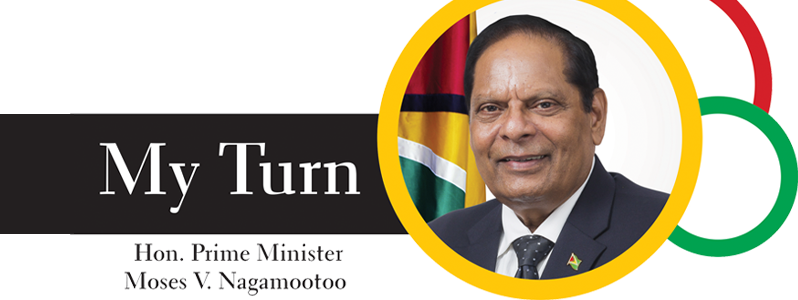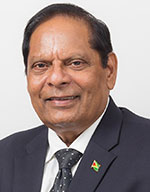I WOULD look out involuntarily every time I approach the “Lowtan Turn” at Cotton Tree in West Berbice for a lamp post where, a few years ago, a cardboard poster was mounted with the slogan: “Down with CorruPPPtion”.
That slogan said it all: the post-Jagan PPP government had become synonymous with corruption. Even erstwhile Jagan loyalists like Ralph Ramkarran and Joey Jagan accused the regime of “pervasive corruption” in the run-up to the May 2015 elections.
QUAGMIRE OF CORRUPTION
We are close to two years after those elections and, not unsurprisingly, people seem to forget the quagmire of corruption into which Guyana had sunk. Guyana was way down at the bottom of the corruption perception ladder, ranking 136 in 2013, among 175 countries. We are still crawling out from the dark hole with the index showing Guyana at 108 in 2016.
Corruption was Guyana’s single biggest human rights violation, as moneys that should benefit our people were diverted into the bottomless pockets of public officials and their cronies. The fence to keep government officials away from the public purse was broken since 2009 when the Chairman of the Integrity Commission resigned.
That pervasive corruption had eaten into the sinews of public life by the time Mr. Bharrat Jagdeo completed his unbroken, 12-year stint as President. So, now, when we hear a jingle begging for his return, I just shrug like my gardener, who disdainfully responded: “bring back who?”
UNBRIDLED POWER
It was the frightening spectre of corruption and authoritarianism that resulted in the once formidable PPP losing its iron grip on unbridled power at the 2011 polls when it was reduced to a minority government. By May 2015, it lost the government.
It was therefore a reasonable expectation that the multi-party, multi-ethnic Coalition that succeeded that regime, would have changed Guyana’s image as the Caribbean’s, corruption capital. At least, it was expected to lay the groundwork for this over the past 23 months, even though it would take years to exorcise this cancer.
Fair-minded people would admit that an opening has been made for clean, decent business. Gone are the ugly sores of mega contracts going to cronies for kick-backs. The open, incestuous relationship between the ruling elite and the narco-criminal enterprise, the phantom killer-squads, money launderers and swindlers has been contained.
OUR OWN JUMBIES
Yes, over these two years we have been haunted by some of our own political jumbies, when we encountered mini episodes of overzealous business dealings as in cases such as the D’urban Park project and the pharmaceutical bond fiasco. But there were no cover-ups. Explanations were sought and answers were given, repeatedly, including in the National Assembly.. I think that we have had our full share of public criticisms and we have collectively learned our lessons.
That lesson is underlined by the need in public life for timely, frank and full disclosures. It was the lack of disclosure, after billions were spent without parliamentary approval, that led to a motion of no confidence being tabled by me against the PPP government. That motion triggered the prorogation of parliament. Fresh elections were prematurely set, and the rest, as the saying goes, is history.
GOOD GOVERNANCE
The image today is not the same. A new contour of good governance is emerging, perhaps too slowly, but people are already seeing evidence of a new, structured and orderly social development, everywhere. Georgetown stands out for what it no longer is: a once garbage-infested, flood-prone, unsightly capital city.
Though heavily criticized, the D’urban Park is a new symbol of pride. In an hitherto urban jungle, there now flutters our majestic, giant Golden Arrowhead. It is visible from all approaches, and invites our daily display of quiet patriotism.
There is, however, imperceptible evidence of our renewal that would include the legal and institutional groundwork for a better, law-governed society. The landscape for a more inclusive and accountable governance process has been enhanced by measures, such as follows:-
1. Holding of local government elections.
2. Establishment of new towns.
3. Commissioning of regional, relay radio stations.
4. Anti-money laundering law; Public Procurement law and establishment of a public procurement commission.
5. Draft revised Code of Conduct for persons in public office.
6. Initial steps for Constitutional Reform.
7. Establishment of the Guyana Extractive Industries Transparency Initiative multi-stakeholders group to help protect proceeds from oil and gas.
8. Passage of State Assets Recovery Agency law, to secure the people’s properties from unlawful appropriation; and enactment of reformed Telecommunications law to not only encourage competition but to stimulate better services
9. Ensuring financial autonomy of both the Parliament and the Judiciary, thus promoting respect for the separation of powers and the Rule of Law and
10. Sparing no efforts at the diplomatic and political fronts to protect Guyana’s land and maritime zones from unlawful claims and encroachment.
PROTESTS AND PICKETING
In these two years, there have been perhaps more sporadic protests and picketing than in any other corresponding period. No protest was broken up by police; no one was slapped or stripped; no one was arrested or tear-gassed; no one was injured or killed. Protests were met with limited compromise, not stubborn resistance or intransigence.
Only an authoritarian state would respond to people’s concerns with suppression of public dissent or curtailment of press freedom. We had put that era to an end in May, 2015.
[The writer, a lawyer, journalist and author, is Prime Minister of Guyana]




.jpg)










